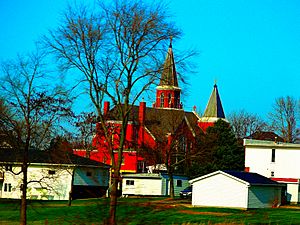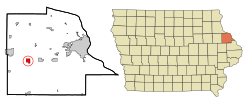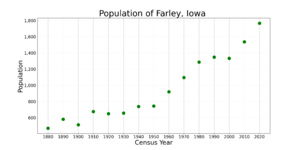Farley, Iowa facts for kids
Quick facts for kids
Farley, Iowa
|
|
|---|---|

St. Joseph's Catholic Church
|
|
| Motto(s):
"Heart of the Cornbelt"
|
|

Location in the State of Iowa
|
|
| Country | |
| State | |
| County | Dubuque |
| Incorporated | June 23, 1879 |
| Area | |
| • City | 1.62 sq mi (4.19 km2) |
| • Land | 1.62 sq mi (4.19 km2) |
| • Water | 0.00 sq mi (0.00 km2) |
| Elevation | 1,119 ft (341 m) |
| Population
(2020)
|
|
| • City | 1,766 |
| • Density | 1,091.47/sq mi (421.37/km2) |
| • Metro | 92,384 |
| Time zone | UTC-6 (CST) |
| • Summer (DST) | UTC-5 (CDT) |
| ZIP code |
52046
|
| Area code(s) | 563 |
| FIPS code | 19-26760 |
| GNIS feature ID | 0456539 |
| Website | www.farleyiowa.com |
Farley is a city in Dubuque County, Iowa, United States. It is part of the Dubuque, Iowa Metropolitan Statistical Area. The population was 1,766 at the time of the 2020 census, up from 1,334 in 2000. Farley is the seventh-largest town in Dubuque County, recently passed by Peosta, Iowa.
Farley is home to a 3/8 mile dirt race track, 300 Raceway.
History
Farley got its start in the 1850s, following construction of the Dubuque and Sioux City Railroad through that territory. Farley was named for the superintendent of the Sioux City Railroad.
Geography
Farley is located at 42°26′38″N 91°0′34″W / 42.44389°N 91.00944°W (42.443999, -91.009385).
According to the United States Census Bureau, the city has a total area of 1.85 square miles (4.79 km2), all land. It is crossed by U.S. Route 20 in the south.
Demographics
| Historical populations | ||
|---|---|---|
| Year | Pop. | ±% |
| 1880 | 471 | — |
| 1890 | 582 | +23.6% |
| 1900 | 513 | −11.9% |
| 1910 | 676 | +31.8% |
| 1920 | 651 | −3.7% |
| 1930 | 657 | +0.9% |
| 1940 | 739 | +12.5% |
| 1950 | 745 | +0.8% |
| 1960 | 920 | +23.5% |
| 1970 | 1,096 | +19.1% |
| 1980 | 1,287 | +17.4% |
| 1990 | 1,348 | +4.7% |
| 2000 | 1,334 | −1.0% |
| 2010 | 1,537 | +15.2% |
| 2020 | 1,766 | +14.9% |
| Source: and Iowa Data Center Source: |
||
2020 census
As of the census of 2020, there were 1,766 people, 654 households, and 467 families residing in the city. The population density was 1,091.3 inhabitants per square mile (421.4/km2). There were 678 housing units at an average density of 419.0 per square mile (161.8/km2). The racial makeup of the city was 96.1% White, 0.2% Black or African American, 0.0% Native American, 0.2% Asian, 0.0% Pacific Islander, 2.0% from other races and 1.4% from two or more races. Hispanic or Latino persons of any race comprised 3.5% of the population.
Of the 654 households, 34.1% of which had children under the age of 18 living with them, 56.1% were married couples living together, 6.7% were cohabitating couples, 19.6% had a female householder with no spouse or partner present and 17.6% had a male householder with no spouse or partner present. 28.6% of all households were non-families. 23.7% of all households were made up of individuals, 6.3% had someone living alone who was 65 years old or older.
The median age in the city was 33.7 years. 30.7% of the residents were under the age of 20; 7.5% were between the ages of 20 and 24; 26.5% were from 25 and 44; 23.0% were from 45 and 64; and 12.3% were 65 years of age or older. The gender makeup of the city was 51.0% male and 49.0% female.
2010 census
As of the census of 2010, there were 1,537 people, 575 households, and 425 families residing in the city. The population density was 830.8 inhabitants per square mile (320.8/km2). There were 586 housing units at an average density of 316.8 per square mile (122.3/km2). The racial makeup of the city was 99.3% White, 0.1% African American, 0.3% from other races, and 0.3% from two or more races. Hispanic or Latino of any race were 1.0% of the population.
There were 575 households, of which 40.2% had children under the age of 18 living with them, 61.4% were married couples living together, 8.5% had a female householder with no husband present, 4.0% had a male householder with no wife present, and 26.1% were non-families. 22.1% of all households were made up of individuals, and 10.8% had someone living alone who was 65 years of age or older. The average household size was 2.67 and the average family size was 3.15.
The median age in the city was 33.8 years. 29.7% of residents were under the age of 18; 7.9% were between the ages of 18 and 24; 28.1% were from 25 to 44; 23.7% were from 45 to 64; and 10.9% were 65 years of age or older. The gender makeup of the city was 49.3% male and 50.7% female.
Education
All public school students living in Farley are zoned to schools in the Western Dubuque Community School District. Elementary school students are zoned to Drexler Elementary School (in Farley) for grades K-5. Middle school students are zoned to Drexler Middle School (also in Farley), and high school students are zoned to Western Dubuque High School, which is in nearby Epworth.
Wayne Drexler Elementary opened in 1993.
Like many other rural communities in Iowa, Farley also has a private school. Seton Catholic Elementary School- Farley is one of three buildings that comprise Seton Catholic Elementary School, and is affiliated with the Roman Catholic Archdiocese of Dubuque. For grades 1–2, students go to the building in Epworth, for grades 3–5, students attend the building in Peosta, Iowa, and for grades 6–8, students go to the building in Farley. For high school, parochial students attend Beckman High School in Dyersville, Iowa or Wahlert High School in Dubuque, Iowa.
Notable people
- William John McGee (1853–1912) Geologist, anthropologist, and archeologist
- Raymond Roseliep, famous poet, Catholic priest
See also
 In Spanish: Farley (Iowa) para niños
In Spanish: Farley (Iowa) para niños



